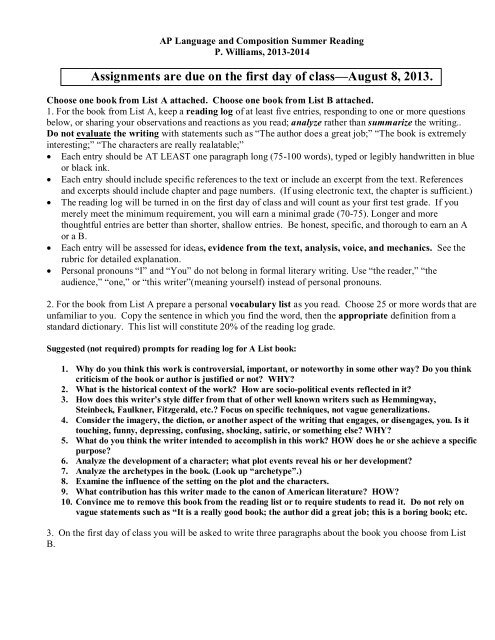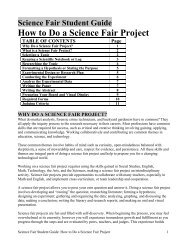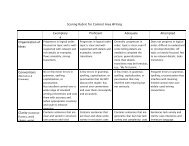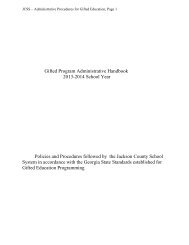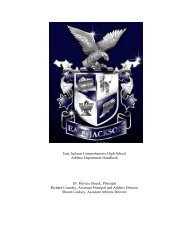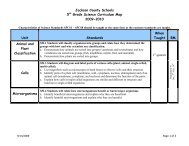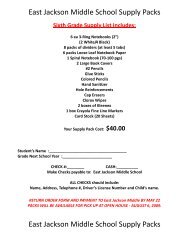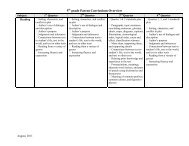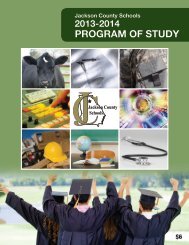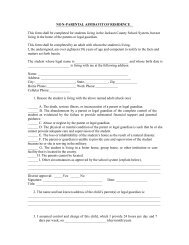AP Language and Composition Summer Reading
AP Language and Composition Summer Reading
AP Language and Composition Summer Reading
Create successful ePaper yourself
Turn your PDF publications into a flip-book with our unique Google optimized e-Paper software.
<strong>AP</strong> <strong>Language</strong> <strong>and</strong> <strong>Composition</strong> <strong>Summer</strong> <strong>Reading</strong>P. Williams, 2013-2014Assignments are due on the first day of class—August 8, 2013.Choose one book from List A attached. Choose one book from List B attached.1. For the book from List A, keep a reading log of at least five entries, responding to one or more questionsbelow, or sharing your observations <strong>and</strong> reactions as you read; analyze rather than summarize the writing..Do not evaluate the writing with statements such as “The author does a great job;” “The book is extremelyinteresting;” “The characters are really realatable;”• Each entry should be AT LEAST one paragraph long (75-100 words), typed or legibly h<strong>and</strong>written in blueor black ink.• Each entry should include specific references to the text or include an excerpt from the text. References<strong>and</strong> excerpts should include chapter <strong>and</strong> page numbers. (If using electronic text, the chapter is sufficient.)• The reading log will be turned in on the first day of class <strong>and</strong> will count as your first test grade. If youmerely meet the minimum requirement, you will earn a minimal grade (70-75). Longer <strong>and</strong> morethoughtful entries are better than shorter, shallow entries. Be honest, specific, <strong>and</strong> thorough to earn an Aor a B.• Each entry will be assessed for ideas, evidence from the text, analysis, voice, <strong>and</strong> mechanics. See therubric for detailed explanation.• Personal pronouns “I” <strong>and</strong> “You” do not belong in formal literary writing. Use “the reader,” “theaudience,” “one,” or “this writer”(meaning yourself) instead of personal pronouns.2. For the book from List A prepare a personal vocabulary list as you read. Choose 25 or more words that areunfamiliar to you. Copy the sentence in which you find the word, then the appropriate definition from ast<strong>and</strong>ard dictionary. This list will constitute 20% of the reading log grade.Suggested (not required) prompts for reading log for A List book:1. Why do you think this work is controversial, important, or noteworthy in some other way? Do you thinkcriticism of the book or author is justified or not? WHY?2. What is the historical context of the work? How are socio-political events reflected in it?3. How does this writer’s style differ from that of other well known writers such as Hemmingway,Steinbeck, Faulkner, Fitzgerald, etc.? Focus on specific techniques, not vague generalizations.4. Consider the imagery, the diction, or another aspect of the writing that engages, or disengages, you. Is ittouching, funny, depressing, confusing, shocking, satiric, or something else? WHY?5. What do you think the writer intended to accomplish in this work? HOW does he or she achieve a specificpurpose?6. Analyze the development of a character; what plot events reveal his or her development?7. Analyze the archetypes in the book. (Look up “archetype”.)8. Examine the influence of the setting on the plot <strong>and</strong> the characters.9. What contribution has this writer made to the canon of American literature? HOW?10. Convince me to remove this book from the reading list or to require students to read it. Do not rely onvague statements such as “It is a really good book; the author did a great job; this is a boring book; etc.3. On the first day of class you will be asked to write three paragraphs about the book you choose from ListB.
<strong>AP</strong> <strong>Summer</strong> <strong>Reading</strong> List A(All of these titles are available in the English book room or in B-11; please request a copy ifneeded.)1. The Adventures of Huckleberry Finn, by Mark Twain, is about a boy named “Huck” <strong>and</strong> his friend, arunaway slave named “Jim,” traveling on the Mississippi River, in pursuit of freedom. Written in the mid-19 th century, the book examines the issue of slavery, as well as other social ills. It is perhaps the mostimportant American novel ever written but is condemned by many because the “n-word” appears morethan 200 times. A satirist <strong>and</strong> a realist, Twain was also an ardent abolitionist. Huck confronts the moraldilemma of slavery <strong>and</strong> eventually resigns himself to “eternal damnation” rather than conform to society’sm<strong>and</strong>ate to betray his friend.2. A Prayer for Owen Meany (1989) by John Irving is the story of two friends growing up <strong>and</strong> copingwith the transition from boyhood to manhood. Since the language is contemporary, the book is notdifficult to read. It is a complicated, funny, sad, <strong>and</strong> thoughtful work with political overtones <strong>and</strong> aprolonged sense of suspense. The narrator is an adult recounting memories of his youth, reflecting on therelationships, personal events, <strong>and</strong> socio-political climate that shaped him as a human being.3. The Grapes of Wrath by John Steinbeck (1939) depicts the struggles of a poor farming family duringthe Great Depression. The Joads are flawed, gritty, unsophisticated, <strong>and</strong> indomitable. They represent thehundreds of thous<strong>and</strong>s of Americans who fled the Dust Bowl to seek a better life in California, only tofind their dreams unattainable. Widely criticized <strong>and</strong> even publicly burned, the book is viewed by some asa Socialist statement about the hopelessness of the American Dream. Others see it simply as a realisticlook at the America of its day. The language is authentic <strong>and</strong> therefore offensive to some readers.4. The Joy Luck Club by Amy Tan (1989) is a mesmerizing tale about the lives of four Chinese womenwho have immigrated to America <strong>and</strong> their daughters, who were born in the US. The characters mustnegotiate the chasm between two cultures <strong>and</strong> between two generations. Tan has an impeccable ear fordialect, great sympathy for her subjects, <strong>and</strong> the power to weave reality <strong>and</strong> myth together seamlessly.Shifting from one point of view to another, the novel juxtaposes the experiences <strong>and</strong> ideals of the eightwomen. This is not an action novel but one of deep character development.5. I, Robot, by Isaac Asimov (1950) is a seminal work of science fiction. (Caution: It bears almost noresemblance to the recent movie of the same title.) Asimov was a scientist before he was a writer, so hiswork is based on scientific imaginings, many of which appear prophetic. The gadgets he created mayseem oddly familiar to readers. The book is actually a collection of related stories rather than one largerstory. Complete with political intrigue as well as futuristic technology, this is one for the true sci-fi lover.6. Ten Great Mysteries by Edgar Allan Poe, a collection of mysteries by the famed master of themacabre! Poe is considered the father of the detective story, as well as the creepiest American writer of alltime. Among lovers of horror, Poe’s popularity is equaled only by that of Stephen King. The language isdifficult, the sentence structure ornate. Be prepared for slow going if you choose this book. If you lovepsychological thrillers, this is an excellent choice.7. The Life of Pi, by Yann Martel (2001) is a novel about the 16-year-old son of a zookeeper whosefamily suffers the sinking of a Japanese cargo ship during a journey from India to America. Pi Patel findshimself in a lifeboat with one other survivor—a 450-pound Bengal tiger. “An impassioned defense ofzoos, a death-defying trans-Pacific sea adventure a la Kon-Tiki, <strong>and</strong> hilarious…This audacious novelmanages to be all of these.” (The New Yorker)
August 7, 2012Reader’s Journal RubricBook:_______________________________Student name: ___________________________________ Grade:_____________DomainIdeas &Analysis(observations,evidence,elaboration,reflection) X2Organization;completeness)X 2Minimal evidence ofst<strong>and</strong>ard2Main idea implied; difficult todiscern. Response does notrespond to the question. Excerpts<strong>and</strong> references missing. Responsecould have been written withoutreading the book. Evaluationrather than analysis.Ideas may be stated but notdeveloped. No elaboration, nosense of completeness. Responsecould have been written withoutreading the book.Mixed or Moderate4 evidence of st<strong>and</strong>ard 86Ideas vague or general; Someunderst<strong>and</strong>ing of text; perfunctoryresponse; only part of task isdone. Excerpts may be few or oflimited value in supportinginterpretation. Plot summaryrather than analysis.Clear beginning, middle, <strong>and</strong> endbut development uneven;Transitions inadequate. Littleelaboration. Gaps in information.Awkward introduction orconclusionStrong evidence ofst<strong>and</strong>ard10Ideas expressed clearly <strong>and</strong>precisely, with appropriateevidence cited in the text.Reflects solid underst<strong>and</strong>ing ofreading, thorough analysis, <strong>and</strong>thoughtful elaboration.Natural progression frombeginning to end; logicalsequence of ideas; full elaborationsupports ideas; effectivetransitions, sense ofcompleteness.Voice (WordChoice; SF)X 2Word choice repetitive, vague,immature. Very poor sentenceformation makes tone tedious.No distinct voice or awareness ofaudience.Word choice generic; sentencesmay be choppy or stringy; tonesomewhat monotonous, uneven,or inappropriate for purpose; littleawareness of audience; littleevidence of writer’s voice.Words chosen carefully foreffective expression. Well craftedsentences produce natural rhythm.Distinct voice <strong>and</strong> awareness ofaudience evident throughout.CUPS & format(capitalization,usage, punctuation,spelling)X 2Vocabulary(thoroughness;accuracy) X 2CUPS errors distract reader. Toofew examples of usage orpunctuation to show solidcompetence. Errors in elementaryfeatures show serious weaknesses.List incomplete; page numbers,chapter references, definitions, orsentences missing in manyinstances. Definitions notappropriate to context. Littleunderst<strong>and</strong>ing demonstrated.CUPS show mixed competence,uneven control. Significant orfrequent errors reveal weaknesses.Evidence is not varied orsophisticated enough to showmastery, even if correct.Missing page numbers, chapterreferences, sentences, orappropriate definitions in somecases. Mixed underst<strong>and</strong>ingdemonstrated.Capitalization, usage,punctuation, <strong>and</strong> spelling showmastery. Evidence is abundant,varied, sophisticated, <strong>and</strong>virtually error-free. Formatshows control <strong>and</strong> awareness ofaudience.List complete. Page numbers <strong>and</strong>chapters cited. Definitions <strong>and</strong>sentences show thoroughunderst<strong>and</strong>ing of words incontext.1. Your comments are vague. I still do not know what you think about the book, or I am not2. certain that you read it from beginning to end.3. Your shared your honest opinions but did not back them up with evidence from the text.4. Watch those ___capitalization ____usage ____punctuation ____spelling errors! Learn the homonymsIts/it’s to/two/too your/you’re their/there5. Entries are thoughtful but not very thorough. Explore more fully.6. Entries are adequate in length but still shallow. You do not really say very much. Dig deeper.7. I enjoyed reading your work. You made some interesting observations.8. You gave me something to think about which had not occurred to me before.9. You raised some interesting questions or criticism.10. Your journal is honest, thoughtful, well supported, <strong>and</strong> thorough. Keep up the good work.


